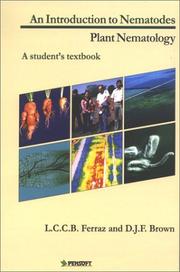| Listing 1 - 10 of 213 | << page >> |
Sort by
|

ISBN: 9546421553 9789546421555 Year: 2002 Publisher: Sofia : Pensoft,
Abstract | Keywords | Export | Availability | Bookmark
 Loading...
Loading...Choose an application
- Reference Manager
- EndNote
- RefWorks (Direct export to RefWorks)
Plant-parasitic nematodes cause an annual global crop yield loss of 10 to 20 percent. This volume introduces the economically important diseases caused by plant-parasitic nematodes, how nematodes parasitise different plant tissues, and the various methods that can be used to control these nematodes.
Periodical
Abstract | Keywords | Export | Availability | Bookmark
 Loading...
Loading...Choose an application
- Reference Manager
- EndNote
- RefWorks (Direct export to RefWorks)
Periodical
Abstract | Keywords | Export | Availability | Bookmark
 Loading...
Loading...Choose an application
- Reference Manager
- EndNote
- RefWorks (Direct export to RefWorks)
Book
Year: 1963 Publisher: London: Edward Arnold,
Abstract | Keywords | Export | Availability | Bookmark
 Loading...
Loading...Choose an application
- Reference Manager
- EndNote
- RefWorks (Direct export to RefWorks)
Book
Year: 1968 Publisher: Jerusalem : Israel program for scientific translations,
Abstract | Keywords | Export | Availability | Bookmark
 Loading...
Loading...Choose an application
- Reference Manager
- EndNote
- RefWorks (Direct export to RefWorks)
Book
Year: 1963 Publisher: London : Arnold,
Abstract | Keywords | Export | Availability | Bookmark
 Loading...
Loading...Choose an application
- Reference Manager
- EndNote
- RefWorks (Direct export to RefWorks)
Book
ISBN: 9789546423245 Year: 2008 Publisher: Sofia, Bulgaria : Pensoft,
Abstract | Keywords | Export | Availability | Bookmark
 Loading...
Loading...Choose an application
- Reference Manager
- EndNote
- RefWorks (Direct export to RefWorks)
Book
Year: 2022 Publisher: Basel : MDPI - Multidisciplinary Digital Publishing Institute,
Abstract | Keywords | Export | Availability | Bookmark
 Loading...
Loading...Choose an application
- Reference Manager
- EndNote
- RefWorks (Direct export to RefWorks)
Nematodes are one of the most important pests globally and can cause up to 14% loss of food crops. In total, nematodes cause over USD 100 billion in global crop damage annually. To date, only a few thousand PPN species have been described. Nematode identification has traditionally relied on morphological and anatomical characters using light microscopy and, in some cases, scanning electron microscopy (SCN). Lately, integrative studies combining molecular diagnosis with morphology and taxonomy have been used to accurately identify and describe nematode species. Detailed analyses of morphological and molecular data have both significantly contributed to our overall understanding of the dynamic and complex nature of plant-nematode interactions. This book includes eleven chapters that cover different aspects of nematology research, from classical morphology and taxonomy to DNA analysis and phylogeny. It also includes very useful information on the rapid detection of plant-parasitic nematodes.
Book
Year: 2022 Publisher: Basel : MDPI - Multidisciplinary Digital Publishing Institute,
Abstract | Keywords | Export | Availability | Bookmark
 Loading...
Loading...Choose an application
- Reference Manager
- EndNote
- RefWorks (Direct export to RefWorks)
Nematodes are one of the most important pests globally and can cause up to 14% loss of food crops. In total, nematodes cause over USD 100 billion in global crop damage annually. To date, only a few thousand PPN species have been described. Nematode identification has traditionally relied on morphological and anatomical characters using light microscopy and, in some cases, scanning electron microscopy (SCN). Lately, integrative studies combining molecular diagnosis with morphology and taxonomy have been used to accurately identify and describe nematode species. Detailed analyses of morphological and molecular data have both significantly contributed to our overall understanding of the dynamic and complex nature of plant-nematode interactions. This book includes eleven chapters that cover different aspects of nematology research, from classical morphology and taxonomy to DNA analysis and phylogeny. It also includes very useful information on the rapid detection of plant-parasitic nematodes.
Book
ISBN: 9389571588 9351245489 9789389571585 9789380235837 Year: 2020 Publisher: New Delhi
Abstract | Keywords | Export | Availability | Bookmark
 Loading...
Loading...Choose an application
- Reference Manager
- EndNote
- RefWorks (Direct export to RefWorks)
pertinent to the related topics and their compilation also made by subject learned scientist. It is to hope that this book will be serving as a good reference book to the subject related researchers and scientists.
| Listing 1 - 10 of 213 | << page >> |
Sort by
|

 Search
Search Feedback
Feedback About UniCat
About UniCat  Help
Help News
News